from A newsletter for proactive planning... In this edition... February 2022 Issue Paying back a director’s loan – beware of the anti-avoidance rules Capital gains tax annual exempt amount – use it or lose it www.compassaccountants.co.uk Should you pay a dividend before 6 April 2022? Limited time penalty waivers for 2020/21 tax returns Employed? What the forthcoming National Insurance increases will mean for you Diary Dates- February 2022

PAGE 2 Transactions between a director and his or her personal or family company are common and a director’s loan account is simply an account for recording the transactions that occur between the two. However, there are tax consequences for the company if the director owes money to the company and the loan remains outstanding nine months and one day after the end of the accounting period in which it was made. This is the date that the corporation tax for the period is due. Where this is the case, the company must pay tax (Section 455 tax) of 32.5% of the overdrawn balance. Avoiding a Section 455 tax charge A Section 455 charge can be avoided if the outstanding loan balance is cleared before the corporation tax due date. However, anti-avoidance rules apply, and care should be taken not to fall foul of these rules. The rules seek to ensure that any repayments are genuine repayments, rather than transactions designed to avoid the Section 455 charge. Rule 1: The 30-day rule The 30-day rule comes into play where, within a period of 30 days of a repayment of more than £5,000, the participator borrows again from the company. Section 455 tax is payable on the lesser of the amount of the loan repaid and the amount re-borrowed. This rule renders the repayment ineffective to the extent that the funds are re-borrowed within 30 days. It doesn’t matter which comes first, the loan repayment or the further borrowing, the 30-day period applies equally. This prevents a participator from taking out a new loan and using it to repay all or part of the original one. Rule 2: The intentions and arrangements rule The intentions and arrangements rule gives the taxman a second bite of the cherry where the 30-day rule does not apply because the period between the repayment and the new loan is more than 30 days. This rule applies a motive test and can catch repayments and further borrowing more than 30 days apart where the intention is to avoid tax. The intention and arrangements rule comes into play where the balance of the loan outstanding immediately before the repayment is at least £15,000 and, at the time a loan repayment is made, there are arrangements, or an intention, to subsequently borrow £5,000 or more. This rule applies even where the new borrowing is outside 30 days. The rule bites if the repayment is made with the intention of redrawing at least £5,000 of the payment, irrespective of when this is done. This means waiting 31 days before re-borrowing the funds will not necessarily work. Again, the rule does not apply to funds extracted by way of a dividend, salary or bonus, as these are within the charge to income tax. Genuine repayment Clearing an outstanding loan balance to avoid a Section 455 charge will only be tax-effective if this is done either by means of dividend, bonus or salary payment, which attract tax charges in their own right, or by using funds from outside the company to make a genuine repayment.
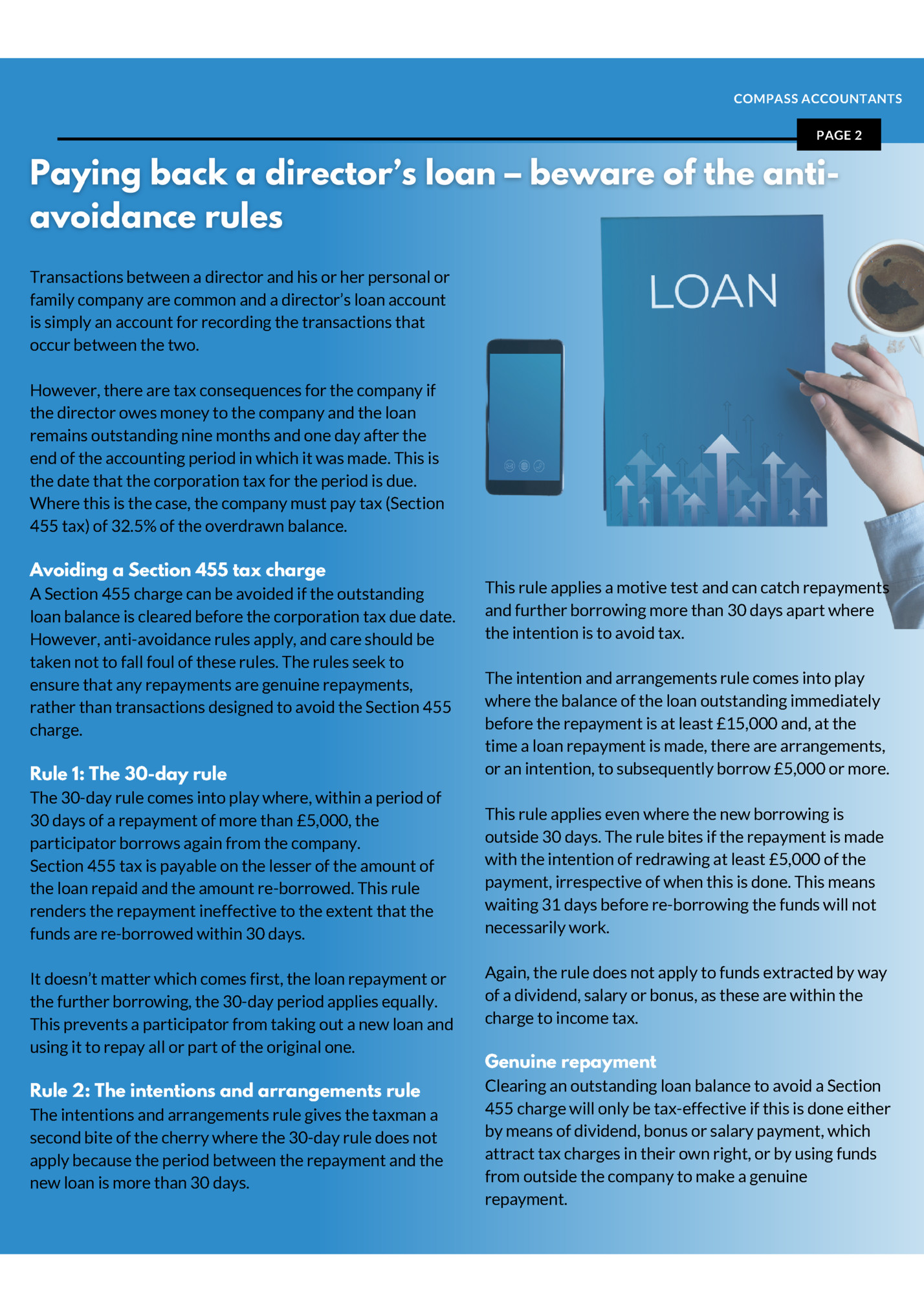
PAGE 4 3 Capital gains tax annual exempt amount – use it or lose it The tax systems contains a number of allowances which enable individuals to enjoy income and gains tax-free. One of these allowances is the annual exempt amount that applies for capital gains tax purposes. For 2021/22, it is set at £12,300. It will remain at this level for 2022/23. Nature of the annual exempt amount The annual exempt amount allows each individual to realise net gains of up to £12,300 in the 2021/22 tax year before any capital gains tax is payable. Spouses and civil partners each have their own annual exempt amount. The annual exempt amount is applied to net gains – that is chargeable gains less allowable losses – for the tax year. Thus, while losses for the tax year must be set against gains for the tax year before applying the annual exempt amount, there is no requirement to use up losses brought forward before utilising the annual exempt amount. If the annual exempt amount is not used in the tax year to which it relates, it is lost – unused amounts cannot be carried forward. Tax planning opportunities The 2021/22 tax year comes to an end on 5 April 2022. The final months of the tax year are a time when it is prudent to review your tax position and consider whether any action should be taken before the tax year comes to an end. From a capital gains tax perspective, it is advisable to review disposals made so far in the tax year and the resulting net gains/losses, and also any planned disposals. If the annual exemption has not been used in full, and a disposal is on the cards which may yield a chargeable gain, consideration could be given to realising the gain in the 2021/22 tax year. This will enable you to take advantage of the annual exempt amount for 2021/22, leaving the 2022/23 annual exempt amount available to shelter the first £12,300 of gains realised in that year. On the other hand, if a disposal is planned before the end of the tax year that will realise a loss and, when set against gains for the tax year, will result in some or all of the annual exempt amount being wasted, consideration could be given to delaying the disposal until 2022/23. This will prevent wasting the 2021/22 annual exempt amount, and also leave the loss available to reduce any 2022/23 gains. Spouses and civil partners each have their own annual exempt amount, and the ability of spouses and civil partners to transfer assets between them at a value that gives rise to neither a gain nor a loss opens further tax planning opportunities when it comes to ensuring that the 2021/22 annual exempt amount is not wasted. If one spouse/civil partner has used all of their annual exempt amount, but their partner’s remains available, transferring the assets (or a sufficient share to use up the available annual exempt amount) prior to sale will ensure that use is made of the available annual exempt amount. Likewise, if neither partner has used their annual exempt amount and the likely gain exceeds £12,300, transferring a share in the asset to their partner prior to sale will enable both annual exempt amounts to be used. Example Tom and Lucy are married. In 2021/22, Lucy sold some shares realising a gain of £13,000. This has used her annual exempt amount in full. Tom has made no disposals in the year. Lucy plans to sell some more shares which she expects will realise a gain of £11,000. She was planning on waiting until after 5 April 2022 to make the disposal. However, if she transfers the shares to Tom prior to sale, and if Tom sells them before 6 April 2022, the gain will fall in the 2021/22 tax year. Consequently, it will be sheltered by Tom’s annual exempt amount for 2021/22, ensuring that this is not wasted, while leaving Lucy’s annual amount for 2022/23 available to set against any other gains in that tax year.
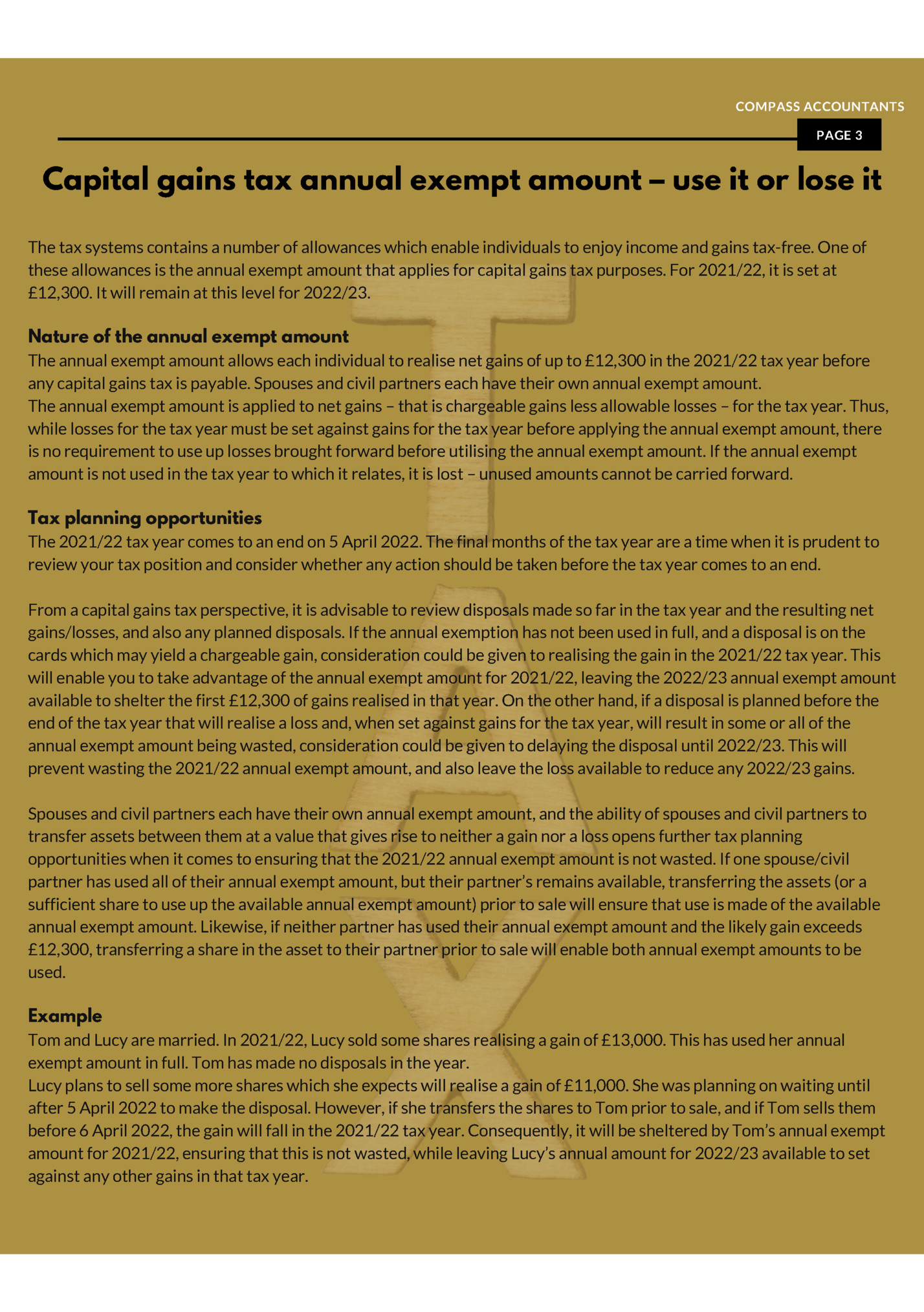
PAGE 4 If you operate your business through a personal or family company and extract profits in the form of dividends, it is prudent to review your dividend policy to determine whether it would be beneficial to pay a further dividend before the end of the 2021/22 tax year on 5 April 2022. It should be remembered, however, that dividends can only be paid if you have sufficient retained profits, and where shares of the particular class in respect of which a dividend is being declared are held by more than one shareholder, in proportion to shareholdings. Paying a dividend before the end of the tax year may be worthwhile if: ·shareholders have unused dividend allowances; or ·to beat the dividend tax rate increases that come into effect from 6 April 2022. Utilise dividend allowances All individuals, regardless of the rate at which they pay tax, have a dividend allowance. This is set at £2,000 for 2021/22. The dividend allowance operates as a zero rate band and dividends (which are taxed as the top slice of income) are tax-free to the extent that are covered by the dividend allowance. However, the dividend allowance does use up part of the tax band in which it falls. If any shareholders have not fully used their dividend allowance for 2021/22, paying a dividend to take their dividends for the tax year up to £2,000 will be beneficial allowing profits to be extracted from the company without any further liability to tax. If an alphabet share structure is used, dividends can be tailored to match the unused amount of the dividend allowance; if there is only one class of share, dividends must be paid in proportion to share holdings. Example Fletcher Ltd is a family company in which Bertie Fletcher and his wife Jane are directors. Bertie holds 100 A Class shares and Jane holds 100 B Class shares. The couple each take a salary, which for 2021/22 is equal to the personal allowance of £12,570. In addition, the company has declared dividends of £37,700 for both A Class and B Class shareholders. The couple have two sons, Chris and David. Chris holds 100 C Class shares and David holds 100 D Class shares. Chris has £1,500 of his 2021/22 dividend allowance available, while David’s dividend allowance remains available in full. To utilise the dividend allowances to extract profits free of tax, the company pays a dividend of £15 per share to C Class shareholders and a dividend of £20 per share to D Class shareholders on 30 March 2022. Chris receives a dividend of £1,500, which are covered by his available dividend allowance, and David received a dividend of £2,000, which is covered by his dividend allowance. No dividends are declared for Class A and Class B shares. Beat the dividend rate rise As part of a package of measures to fund health and social care, the rates at which dividends are taxed are to rise by 1.25% from 6 April 2022. This will mean that for 2022/23, dividends will be taxed at 8.75% to the extent that they fall in the basic rate band (currently taxed at 7.5%), at 33.75% to the extent that they fall in the higher rate band (currently 32.5%) and at 39.35% to the extent that they fall within the additional rate band (currently 38.1%). The dividend allowance will remain at £2,000 for 2022/23. CONTINUED ON PAGE 5
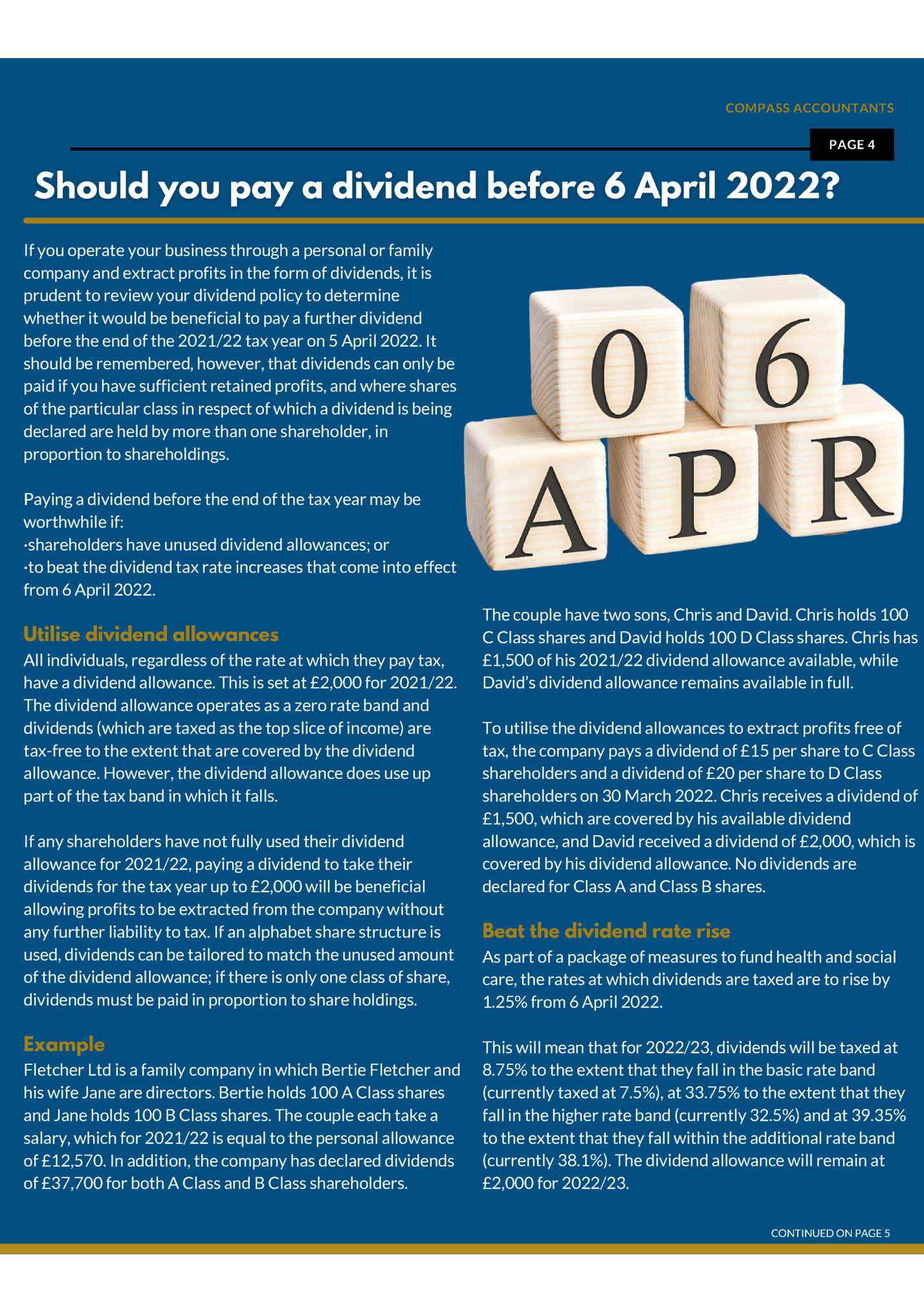
PAGE 5 If retained profits permit, it may be advisable to pay dividends before 6 April 2022 if doing so means that they are taxed at a lower rate than if paid after that date. However, if paying a further dividend before 5 April 2022 means that it will fall in a higher tax band than if paid after that date, it will not be beneficial – it is preferable to pay tax at 8.75% than at 32.5%. Example Ali is the director of his personal company A Ltd. In 2021/22 he is paid himself a salary of £9,568. He also received a dividend each year of £20,000 on 30 April. He has retained profits of £50,000. If instead of paying the dividend of £20,000 that is due to be paid on 30 April 2022, £18,000 of that dividend is paid on 30 March 2022, the tax payable will be £1,350 (£18,000 @ 7.5%) rather than £1,575 (£18,000 @ 8.75%) if the dividend is paid on 30 April 2022. The remaining £2,000 of the dividend can be paid on 30 April 2022 as planned as it will be sheltered by the dividend allowance for 2022/23. Paying £18,000 of the dividend before 6 April 2022 to beat the tax rise will save Ali £225 in tax. To help meet the costs of health and adult social care, a new levy, the Health and Social Care Levy, is introduced from 6 April 2023. Payment of the levy, which is set at the rate of 1.25% of qualifying earnings, is linked to the payment of National Insurance contributions. Prior to the introduction of the levy and in order to start raising ring-fenced funds for health and adult social care from 6 April 2022 onwards, the rates of ‘qualifying’ National Insurance contributions are to increase by 1.25% for 2022/23 only. Qualifying National Insurance contributions are Class 1, Class 1A, Class 1B and Class 4. Thus, employees, employers and the self-employed will be hit by the rises for 2022/23, and by the levy from 6 April 2023. The National Insurance rates are due to revert to their 2021/22 levels from 6 April 2023 when the Health and Social Care Levy comes into effect. Impact on employees For 2022/23, employees will pay primary National Insurance contributions at the main rate of 13.25% on earnings between the primary threshold (set at £190 per week for 2022/23) and the upper earnings limit (set at £967 per week for 2022/23), and at the additional rate of 3.25% on earnings in excess of the upper earnings limit. For 2021/22, the main rate is 12% (payable on earnings between £184 per week and £967 per week) and the additional rate is 2% (payable on earnings in excess of £967 per week). The following case studies demonstrate the impact of the rate rises, which will depend to the extent to which they are offset by the increase in the primary threshold. CONTINUED ON PAGE 6
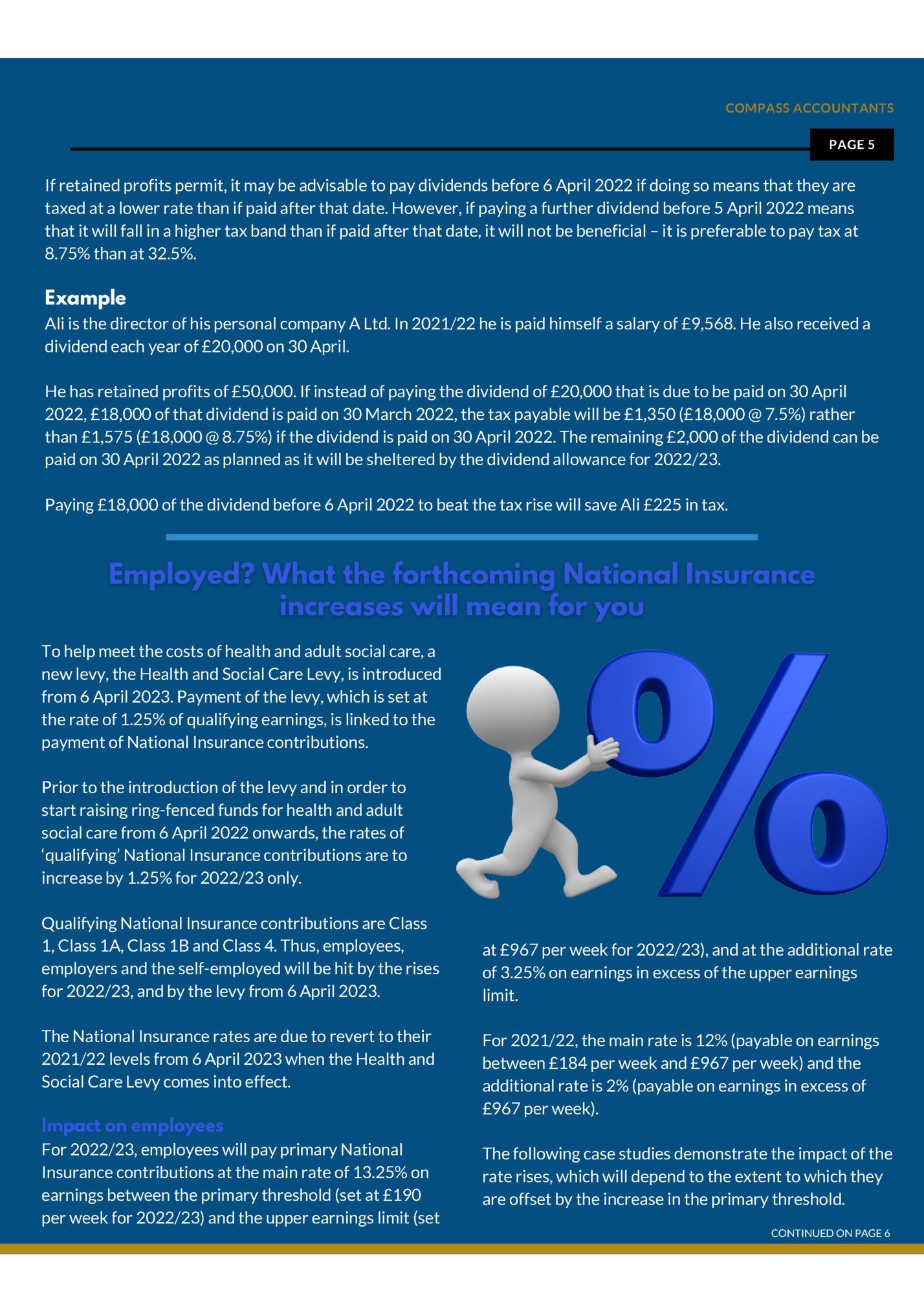
PAGE 6 Case study 1 Karen is paid £185 per week. For 2021/22, she pays primary contributions of 12p per week. However, for 2022/23, she will not pay any contributions (but will be treated for state pension purposes as having made national contributions) as her earnings are below the primary threshold of £190 per week. She is unaffected by the rate rises, and benefits from the increase in the primary threshold. Case study 2 Clive is paid a salary of £24,000, paid monthly at the rate of £2,000 per month. His pay remains the same in 2022/23 as in 2021/22. The monthly primary threshold is £833 for 2022/23 and the monthly upper earnings limit is £4,189. For 2021/22, the monthly primary threshold is £797 and the monthly upper earnings limit is £4,189. For 2021/22, Clive pays primary National Insurance contributions of £144.36 (12% (£2,000 - £797)). For 2022/23, Clive pays primary National Insurance contributions of £154.63 ((13.25% (£2,000 - £833). The combined impact of the rate rise and the increase in the primary threshold will mean that Clive will pay an additional £10.27 each month in National Insurance contributions. Case study 3 Rebecca is a company director with a salary of £150,000 a year. The annual primary threshold is £9,880 for 2022/23 and £9,568 for 2021/22. The annual upper earnings limit is £50,270 for both years. For 2021/22, Rebecca pays primary Class 1 National Insurance of £6,878.84 ((12% (£50,270 - £9,568)) + 2% (£150,000 - £50,270))). For 2022/23, Rebecca pays primary Class 1 National Insurance of £8,592.91 ((13.25% (£50,270 - £9,880)) + (3.25% (£150,000 - £50,270))). As a result of the rate increases, Rebecca will pay £1,713.07 more in National Insurance contributions in 2022/23 than in 2021/22.
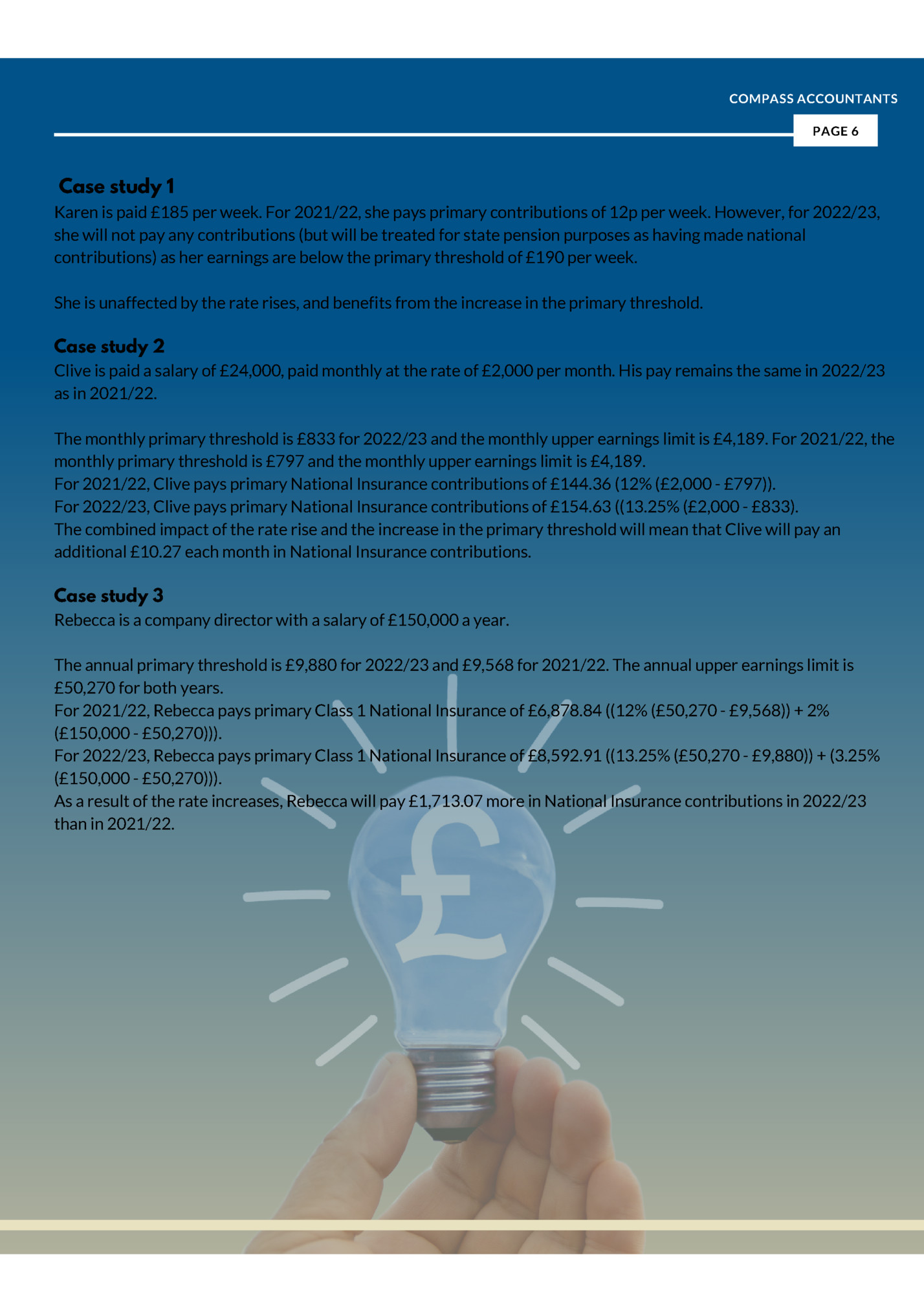
PAGE 7 Limited time penalty waivers for 2020/21 tax returns To help taxpayers and advisers affected by the surge in Covid-19 cases as a result of the Omicron variant, HMRC have announced that penalty waivers will apply for a limited time where the 2021/22 tax return is filed late or where tax due on 31 January 2022 is paid late. Late filing penalty The 2020/21 tax return was due to be filed online by midnight on 31 January 2022. Where this deadline is missed, normally HMRC would charge a late filing penalty of £100 automatically. The exception to this rule is where the notice to file a 2020/21 tax return was issued after 31st October 2021, in which case a later filing deadline of three months from the date of the notice to file applies. Where a late filing penalty is issued, the taxpayer can appeal the penalty if they have a ‘reasonable excuse’ for missing the deadline. However, in recognition of impact of Covid-19 on the ability of taxpayers and their agents to meet the 31 January 2022 deadline, HMRC have announced that they will not charge a late filing penalty as long as the 2021/22 tax return is filed by midnight on 28 February 2022. This will give taxpayers an extra month in which to file their return. The move is perhaps not entirely altruistic on HMRC’s part as it is likely to save them from dealing with a large number of penalty appeals where the late filing is attributable to the reasonable excuse of Covid-19. Late payment penalty A tax payment deadline also fell on 31 January 2022. This is the date by which any tax and National Insurance still due for 2020/21 must be paid, along with the first payment on account for the 2021/22 tax year. Normally, a late payment penalty of 5% of the outstanding tax would be charged where tax due by 31 January 2022 remained unpaid by 31 March 2022. However, HMRC have announced that they will not charge a late payment penalty as long as the taxpayer has paid their tax in full or agreed a Time to Pay arrangement with HMRC by midnight on 1 April 2022. If you know already that you will struggle to pay your tax bill in full by 1 April 2022, you should act now to set up a Time to Pay arrangement, which will allow you to pay what you owe in instalments. Interest Interest payments have not been waived. Where tax is not paid by 31 January 2022, interest will run from 1 February 2022 until the date of payment.
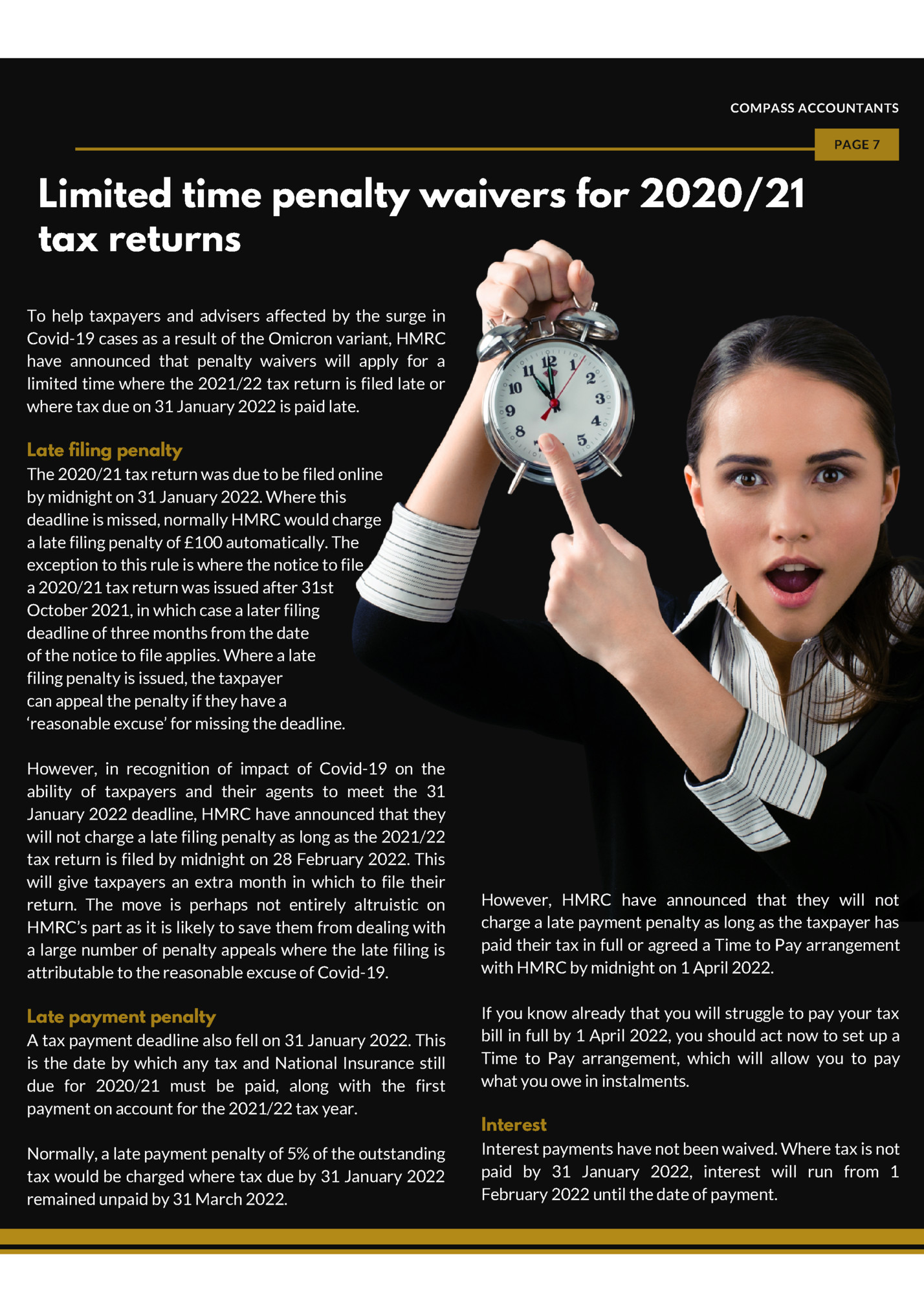
PAGE 8 TAX DIARY FEBRUARY 2022 1 February 2022 – Due date for Corporation Tax payable for the year ended 30 April 2021. 19 February 2022 – PAYE and NIC deductions due for month ended 5 February 2022 (If you pay your tax electronically the due date is 22 February 2022). 19 February 2022 – Filing deadline for the CIS300 monthly return for the month ended 5 February 2022. 19 February 2022 – CIS tax deducted for the month ended 5 February 2022 is payable by today. For further information on any of the stories in this month’s newsletter, or for any other matter that Compass Accountants can assist you with, please contact us on 01329 844145 or contact@compassaccountants.co.uk To subscribe to the newsletter, so that each edition is delivered to your inbox, go to www.compassaccountants.co.uk and add your contact details. Compass Accountants, Venture House, The Tanneries, East Street, Titchfield Hampshire. PO14 4AR
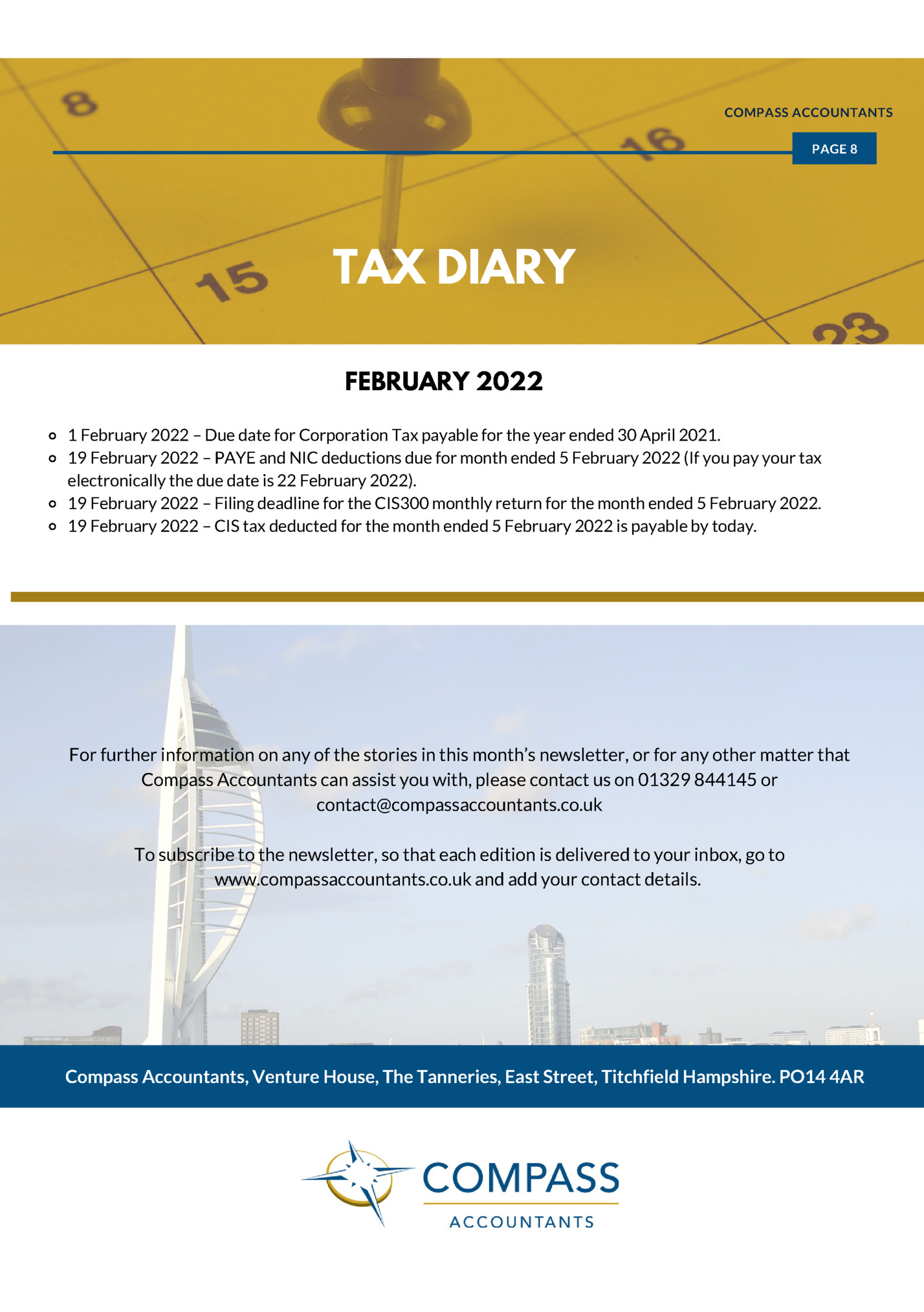
Fleepit Digital © 2021